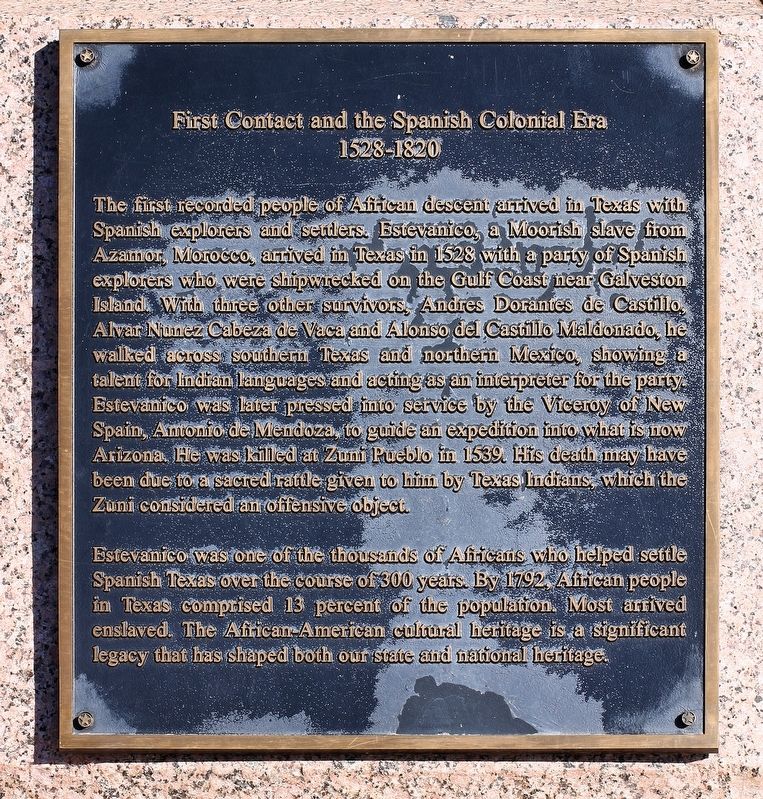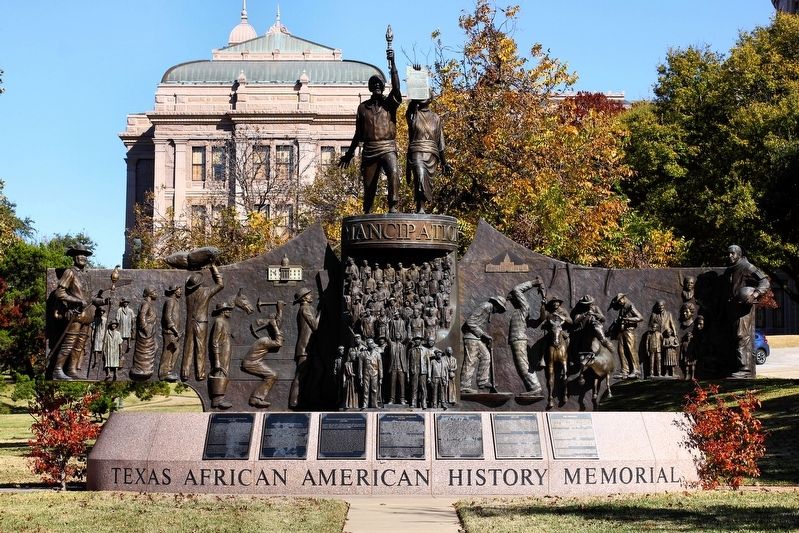Downtown Austin in Travis County, Texas — The American South (West South Central)
First Contact and the Spanish Colonial Era
1528-1820
Inscription.
The first recorded people of African descent arrived in Texas with Spanish explorers and settlers. Estevanico, a Moorish slave from
Azamor, Morocco, arrived in Texas in 1528 with a party of Spanish explorers who were shipwrecked on the Gulf Coast near Galveston Island. With three other survivors, Andres Dorantes de Castillo,
Alvar Nunez Cabeza de Vaca and Alonso del Castillo Maldonado, he walked across southern Texas and northern Mexico, showing a talent for Indian languages and acting as an interpreter for the party. Estevanico was later pressed into service by the Viceroy of New Spain, Antonio de Mendoza, to guide an expedition into what is now Arizona. He was killed at Zuni Pueblo in 1539. His death may have been due to a sacred rattle given to him by Texas Indians, which the Zuni considered an offensive object.
Estevanico was one of the thousands of Africans who helped settle Spanish Texas over the course of 300 years. By 1792, African people in Texas comprised 13 percent of the population. Most arrived enslaved. The African-American cultural heritage is a significant legacy that has shaped both our state and national heritage.
Erected 2016 by the Texas African American History Memorial Foundation.
Topics. This historical marker is listed in this topic list: African Americans . A significant historical year for this entry is 1528.
Location. 30° 16.398′ N, 97° 44.491′ W. Marker is in Austin, Texas, in Travis County. It is in Downtown Austin. Marker is at the intersection of West 11th Street and Congress Avenue, on the right when traveling west on West 11th Street. Marker is on the grounds of the Texas State Capitol. Touch for map. Marker is at or near this postal address: 1100 Congress Avenue, Austin TX 78701, United States of America. Touch for directions.
Other nearby markers. At least 8 other markers are within walking distance of this marker. Slavery During the Mexican National Era (here, next to this marker); Slavery During the Republic and Early Statehood (here, next to this marker); Civil War, Emancipation and Juneteenth (here, next to this marker); The 21st Century (here, next to this marker); Reconstruction and the Post Slavery Experience (here, next to this marker); Hendrick Arnold and Samuel McCulloch, Jr. (here, next to this marker); Post Reconstruction Challenges and Achievements (here, next to this marker); Major Achievements (here, next to this marker). Touch for a list and map of all markers in Austin.
More about this marker. The marker is one of ten markers on the Texas African American History Memorial. The monument honors the many contributions of African Americans in Texas. The markers trace the history of African Americans from the 1500s to the present.
Credits. This page was last revised on February 1, 2023. It was originally submitted on December 20, 2020, by Larry D. Moore of Del Valle, Texas. This page has been viewed 401 times since then and 64 times this year. Photos: 1, 2. submitted on December 20, 2020, by Larry D. Moore of Del Valle, Texas.

